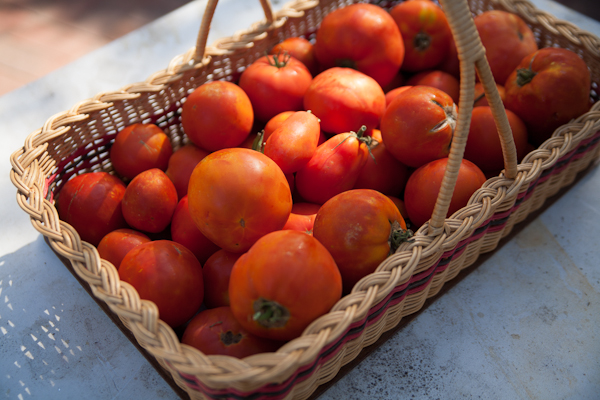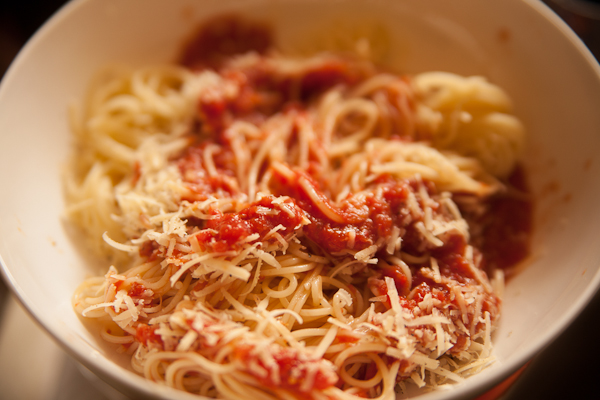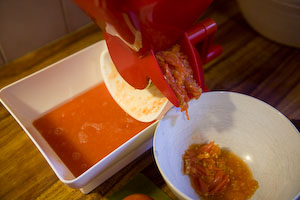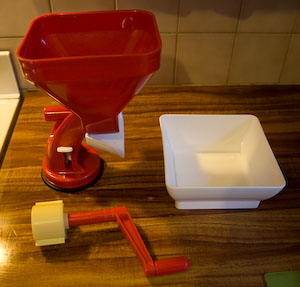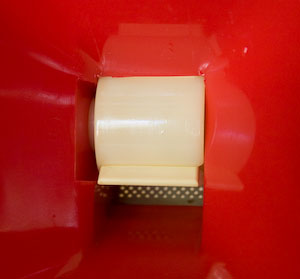The end of summer is a delicious time. The last month or two we have had tons of zucchinis, eggplant, onions, apples, peaches and more but just maybe the most delicious – beautiful tomatoes. We eat as many as we can and bottle the rest as sauce. I can’t recommend this enough – if you can start with good, ripe tomatoes and make a simple sauce the difference between home made and bought sauces is mind blowing.
If you’re growing your own tomatoes it makes sense to save up as many as possible and do one big sauce making session. This usually means picking as they ripen and storing in the fridge for a few days while stocks slowly build up. When we haven’t grown our own some years we have bought a few boxes from farmers markets or grocers.
The best way we’ve found to make a simple sauce is to simmer the tomatoes in big pots until just soft, then let them sit in a colander for a minute to drain. Or you could try the approach of roasting your tomatoes first – this does look pretty tasty I admit! After cooking, use a tomato mill like the one I reviewed here last year or a mouli (vegetable mill) to get the skin and seeds out. You can jar them at this point but you’ll probably end up with quite a runny sauce, which will separate in the jars. This isn’t such a bad thing but this year we took our sauce and simmered it over low heat for a few hours, until reduced in volume by about a quarter. The taste of this reduced sauce… I’m drooling again thinking about it.
There are lots of different styles of jars for preserving or ‘canning’ vegetables. Although expensive new, we have found many crates of them at garage sales and op shops for a fraction of the price – just make sure you can still get the rings and lids for whichever ones you get. We use Fowlers brand jars as the parts are available new if you need them. To use these jars you fill to about an inch from the top, and slip over a rubber seal, the lid and a clip to hold it down. Before we got jars we used long neck beer bottles with crown caps from a homebrew store, and you can save and reuse any jars or bottles as long as they have good metal lids.
When full put all of your jars in a big stock pot and add water to just below the lids and slowly bring to a low boil. I boil the jars for an hour, then let them cool slowly in the hot water to be on the safe side.

If you have a dedicated ‘Vacola’ pot for boiling the jars, it has a raised platform in the bottom so that the jars aren’t right on the hot bottom of the pot. If you’re using a stock pot, bring to the heat slowly or the jars can crack – either from the heat or bubbles jittering them around. I’ve seen people put rags or tea towels on the bottom to stop this happening.

If you’ve been making sauce all day and need a quick meal, take a ladle full of your fresh sauce, grind in a little salt and pepper, cook up whatever pasta you have lying around – thick shapes like spirals work well but anything goes and hit it with the sauce. Grate a little parmesan on top if you have it. Might not look like much but the clean flavours and textures are so good.
More:
Mouli on Amazon (or try second hand shops) – this is a good, cheap option for making smaller batches of sauce.
The Squeezo – I covet this after reading eatatdixiebelles post about it
